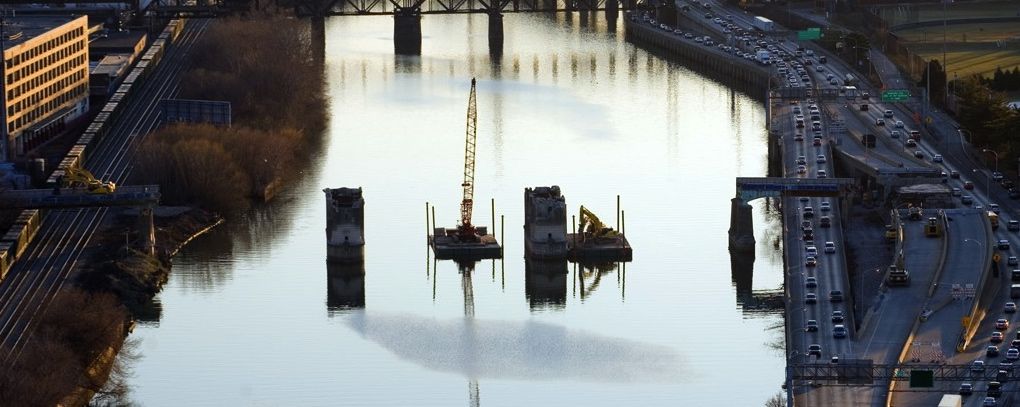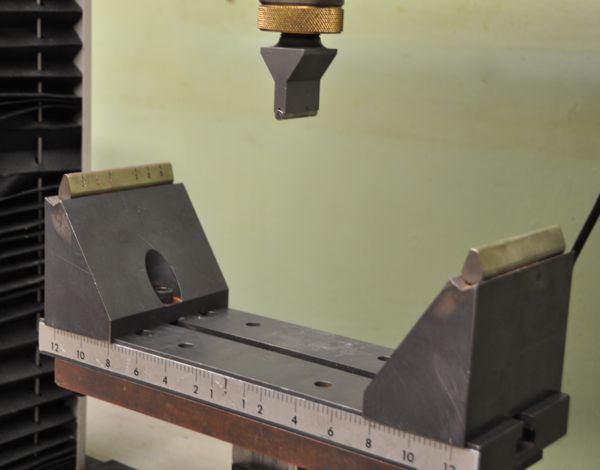MEAM.Design - MEAM 247 - P3: Span

Dates & Deadlines
| 11/16, 6:00 p.m. | team formation deadline |
| 11/30, 11:59 p.m. | prediction deadline |
| 12/2, 5:00 p.m. | official testing deadline |
Team Formation
You will need to work within a team of three (new) people for this project. Add your name to a team here before 6:00 p.m. on November 16th. Those not listed on the page by the deadline will be randomly assigned.

The Schuylkill Instron River
Located in the basement of the LRSM is the little-known Schuylkill Instron River. But it needs a bridge. And not just any bridge. It needs a bridge that has a maximized strengh-to-weight ratio with a minimum of deflection. Fortunately, you have a pile of MDF, a bunch of creativity, and a wealth of knowledge about statics and strength of materials. Here are the details and constraints:
Support pylons can be found on each side of the Schylkill Instron River. Your bridge can touch only the top surface of these pylons, which have a top radius of approximately 2.5mm and are spaced 30.5 centimeters (12 inches) apart.
Your bridge can extend no more than 10 centimeters above and 0 centimeters below the pylons.
Your bridge must be no more than 10 centimeters wide.
A continuous roadbed must span the entire river, and must be at least 5 centimeters wide and no more than 3 centimeters above the top plane of the pylons.
In the center of your span you must include a clear vertical opening of at least 5 by 5 centimeters to accommodate the load applicator.
You can use only 1/8-inch and 1/4-inch MDF for your bridge. No adhesives. No fasteners. Nothing but MDF.
Your bridge must have a mass of no more than 500 grams.
For testing, a 4.5-centimeter wide by 11.4 centimeter long "car" will be placed in the center of your bridge, and the load applicator will be lowered through the opening to apply a force to the top of the car.
The Properties of MDF
What is MDF, anyway? Well, it's "an engineered wood product formed by breaking down hardwood or softwood residuals into wood fibers, often in a defibrator, combining it with wax and a resin binder, and forming panels by applying high temperature and pressure" (thank you, Wikipedia). To aid in the design process, you'd probably like to know about the mechanical properties of this stuff. Fortunately, we have undertaken the task of mechanically testing a few specimens. The Instron data for these tests can be found here (4 in tension, 5 in compression, and 4 in 3-point bending).
Acquiring MDF
You can order what you need here.
Predictions (due by 2:00 p.m. on 11/28 11:59 p.m. on 11/30)
Using your in-depth knowledge of strength of materials, together with the specimen data above, you should be able to formulate a reasonable approximation for the load capacity and deflection characteristics for your bridge. Once finalized, you will need to send your predictions (max load in Newtons and deflection at failure in mm), along with a CAD rendering (800x400 pixel JPG) of your design in an email to medesign@seas.upenn.edu entitled 247-P4-Prediction-TXX, where XX is your team number.
Preliminary Testing
If you would like to run any preliminary tests, the LRSM lab will be open for testing on a first-come, first-served basis during the following dates/times:
11/29: 10:00 a.m. - 12:00 p.m., 2:00 - 4:00 p.m.
11/30: 2:00 - 4:00 p.m.
Testing to Failure
The LRSM lab will be open for official testing on a first-come, first-served basis during the following dates/times:
12/1: 10:00 a.m. - 12:00 p.m., 2:00 - 4:00 p.m.
12/2: 11:00 a.m. - 3:00 p.m.
We will have a video camera set up to capture your bridge's final performance. Once complete, you will need to enter the failure load and deflection on the Competition page, calculate your final score according to the formula below, and then you're done.
($$ S = \frac{P}{m} \left(1 - \frac{d}{60}\right) $$)
where P is the load in Newtons, m is the mass in grams, and d is the deflection in millimeters.
Good Luck
(image credit: phillyskyline.com/misc/wallpaper_090220a.jpg)